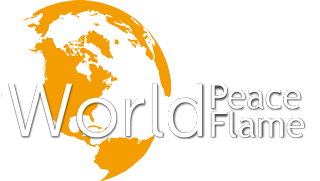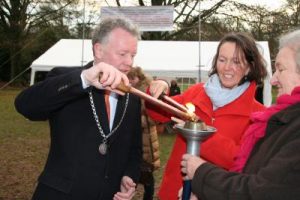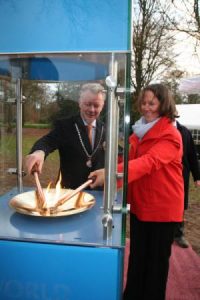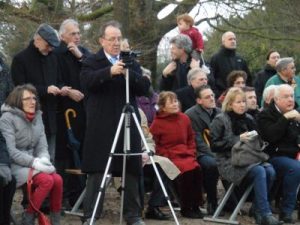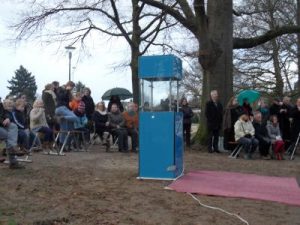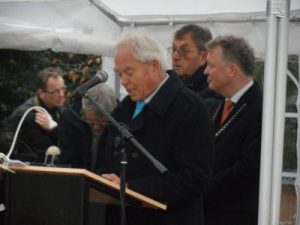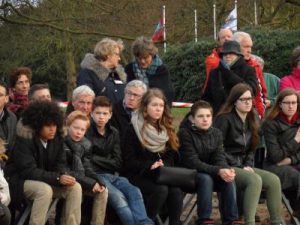World Peace Flame monument in Oosterbeek, NL
 The World Peace Flame monument at the Airborne Museum in Oosterbeek (Netherlands) was inaugurated at 15.30 hours on Saturday 20 December. Lighting the flame was the Mayor of Renkum Jean Paul Gebben and Savitri MacCuish, director of the World Peace Flame Foundation. The flame was lit from the World Peace Flame at the Vredespaleis (the ‘Peace Palace’) in The Hague, where it was handed over by Steven Hoogstraten, director of the Peace Palace, to pupils of the Dorenweerd College in Doorwerth. The pupils brought the flame to the school in a mineworkers lamp, after which it was transported to the Airborne Museum for the inauguration ceremony.
The World Peace Flame monument at the Airborne Museum in Oosterbeek (Netherlands) was inaugurated at 15.30 hours on Saturday 20 December. Lighting the flame was the Mayor of Renkum Jean Paul Gebben and Savitri MacCuish, director of the World Peace Flame Foundation. The flame was lit from the World Peace Flame at the Vredespaleis (the ‘Peace Palace’) in The Hague, where it was handed over by Steven Hoogstraten, director of the Peace Palace, to pupils of the Dorenweerd College in Doorwerth. The pupils brought the flame to the school in a mineworkers lamp, after which it was transported to the Airborne Museum for the inauguration ceremony.
The initiative for the World Peace Flame monument was taken by four residents of Renkum: Monique Schieman, André van Schaveren, Nikel Lambrechtsen and Peter de Jong. They were inspired by other World Peace Flame monuments, and by a dream that is both simple and ambitious. This single, inspiring peace flame unites people around the world – men, women and children alike, from every country, and regardless of religion or belief. The initiators saw the Airborne Museum in Oosterbeek as the ideal location for a WPF monument because it perfectly symbolises the link between ‘remembrance’ and ‘the way forward to peace’. The project had the full cooperation of the municipal council of Renkum and the committee of the Airborne Museum, with financial support by a number of funds, service associations and private organisations.
Mayor Gebben of Renkum said he was delighted with the World Peace Flame monument. ‘This is a dream location, and the monument is so appropriate that we should really be surprised that it hasn’t been built much earlier at this location. I would like to thank all those who took this initiative on behalf of the municipality of Renkum for their vision and efforts’.
Monique Schieman said children all have the same right to live in peace and love. ‘I invite everybody to think about what they would most like to pass on to our children and grandchildren. For example good toys, without violence or aggressive game. Aggression creeps into people’s lives through TV, games and bullying. That means children all too often see people solving arguments with violence, instead of through a discussion’. She urged parents and teachers to make their voices heard more strongly in the face of so much violence on TV, in games and in the world around us. ‘We can teach our children that a lot more can be achieved by attention and love, instead of through arguments, ill-will and hate. We can serve as an example in achieving that. Because peace starts with ourselves, our children, our own families and the people around us. We need to be aware of that if we want to spread peace among others’.
Savitri MacCuish talked about the projects that the WPF Foundation sets up and supports. ‘The results of those projects can only be achieved through people who work together. Peace isn’t a task that we can just leave to other people. It’s something that each one of us can help to create in his or her own way. The WPF is a symbol for the fact that peace is achieved by people like you and me, leading lives like ours in countries all around the world’. Eleanor Roosevelt once said ‘It isn’t enough to talk about peace. One must believe in it. And it isn’t enough to believe in it. One must work at it’. The WPF in Oosterbeek shows us that by working together with others we can achieve something that can inspire others towards peace. Peace starts here and now. Nothing we do can change the past, but everything we do influences the future’. Savitri invited the audience to think about how we can all contribute to peace. ‘Every time you pass the monument, ask yourself the question: what can I do towards peace in my family and among my friends? The more peace and light we spread, the more we contribute to peace in the world. Everything we do has an effect that can make the difference. Think about that as if it’s the most important question you have to answer!’

